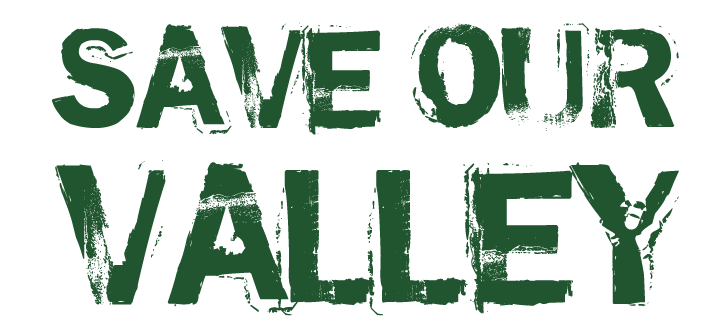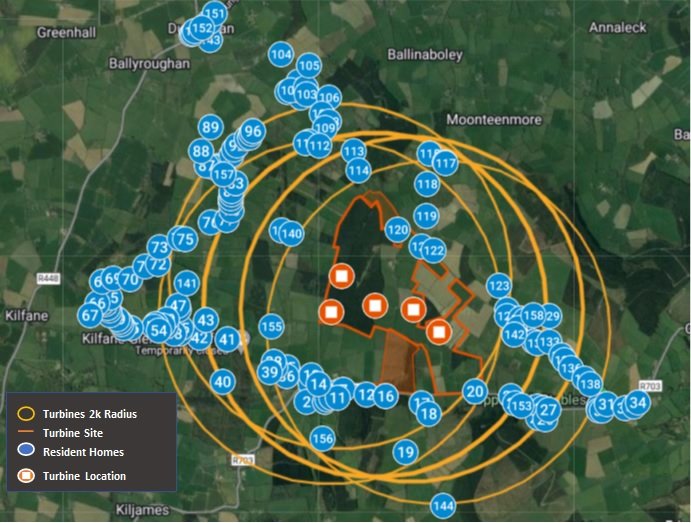Welcome to the Save Our Valley website
We are a rural, upland community in The Coppenagh Gap just outside Thomastown, County Kilkenny, trying to protect our way of life, look after the health of our families and livestock, prevent the industrialisation of wildlife habitats, preserve the county’s landmark landscapes for future generations and protect the property rights of local people. Our mission is to Save Our Valley! From what? Profit-driven, giant, industrial installations being placed within 2km of over 150 homes (and in many cases within 750m), overruling our objections and destroying the county’s heritage.
About the Proposed Wind “Farm”
In March 2022, the residents of Coppenagh Gap were informed that RWE Renewables Ireland Ltd were to seek planning permission for five 600ft (180m) turbines in this small valley.
Details:
Location: In Coppenagh Gap, between Thomastown and Graiguenamanagh in Co. Kilkenny, beneath Mount Brandon, 3.5km south east of Dungarvan Glebe and 6km north east of Thomastown
Impacted land area: Advised as about 521 acres (211 hectares)
Capacity: 5MW per turbine
Homes within 2km of turbines: 150+ homes
Survey: 85% of residents are against this
Construction timeframe: Multi-year anticipated
Developer planning application expected in January 2023
Developer: RWE AG (Rheinisch-Westfälisches Elektrizitätswerk AG), a German multinational company with a fossil fuel background, with an Irish subsidiary based in Kilkenny City
Nearest 180m high turbines to our valley: Located in remote peatlands in Oweninnny, Co. Mayo, a 4-hour drive from here
“Indicative” maps have been shared by RWE ahead of submitting a planning application. The scale of the development site “grew” between March 2022 and July 2022. The footprint and scale could change again at application point.
Offshore not Onshore
Everyone understands the need to increase renewable energy as we approach “peak oil” (the point when extraction of oil becomes unaffordable), but it needs to be done in a way that makes sense. Ireland is fortunately already a world leader in onshore wind energy per capita.
While the government’s offshore wind energy targets exceed onshore by 2050, Ireland is way behind on those offshore targets. Why? Onshore, upland communities are the soft, quick win targets for An Bord Pleanala – a statutory planning body whose former Deputy Chairman of the Board Paul Hyde is under criminal investigation. An Inquiry has also been launched into the activities of the Dublin-based body.
Wind energy is inefficient when compared with existing forms of energy and requires base load capacity anyway – effectively a dual system, when wind turbines cannot run (60% to 70% of the time). The turbines only run in a “goldilocks” zone. Wind energy is economically viable in Ireland through tax-payer funded subsidies via various schemes, e.g. REFIT (Renewable Energy Feed In Tariff) and RESS (Renewable Energy Support Scheme). While people’s electricity bills soared in 2022, electricity companies, using these schemes, made super-normal profits.
Over the years, the height of onshore wind turbines has steadily increased, while the 2006 legislation governing minimum set-back distances has not kept pace. The 600ft (180m) high turbines proposed in our valley are not yet commonly found onshore on the island. The question is: why are these huge turbines not being deployed at sea, instead of on people’s doorsteps?
Hydro and Gas?
Hydro-electric power is currently the Cinderella of renewables, but has incredible power-generating capacity in comparison to wind energy. Historically, Ireland has made full use of its rivers to power its industries - watermills of all types, quarries, sawmills and distilleries. These sites and much of the infrastructure remains; you only have to walk along the Nore from Kilkenny to Bennettsbridge to see the evidence. Ireland’s only pumped hydroelectric storage plant at Turlough Hill in Wicklow comprises four reversible pump turbines with a combined capacity of 292 MW, with approximately 573,000 MW/h annual storage capacity. By comparison a single, modern wind turbine generates 5 MW of electricity, and only when the wind is blowing! The proposed Silvermines Hydro’s 360 MW plant will have approximately 650,000 MW/h annual storage capacity. Full planning permission for this major private project is expected to be sought in early 2023, with delivery in 2028. How many wind farms will need to litter Ireland’s landscape and how many rural communities will be broken to generate 360 MW of energy?
Natural gas was recently declared a “green” energy by the EU, and is a good choice to manage a gradual change from fossil fuels to renewables. Ireland has natural gas fields offshore, e.g. Corrib, Co. Mayo (and adjacent fields) and Barryroe, Co. Cork. Why has the government not yet reversed its February 2021 ban on new gas exploration licences, particularly in light of the recent energy crisis on the Continent?
Land Use & Rezoning?
In many countries, land zoning is the first crosscheck in any development before planning applications can be made. Key land zone categories include industrial, commercial, agricultural, forestry, retail and residential uses.
Typically in other countries, developments of even a very small scale need to apply for rezoning permission, a lengthy process, before any planning application process kicks off, if land use is changing. The land use change is then carefully considered in the context of local, regional, provincial and national plans, a distinct and separate process from the planning application that follows.
It is extraordinary that a large-scale industrial development of at least 520 acres, proposed by a private and commercial German fossil fuels company, does not have to apply to rezone the land from an agricultural/forestry zone to an industrial and/or commercial zone.
There are no such crosschecks or limits on the industrialisation of any given rural area like our valley. In Co. Kilkenny, 80% of the land is “open for consideration” for wind farms, and 100% of the land is available for solar farms. How can rural Ireland survive in the face of this onslaught, sanctioned by government, legislative and planning authorities?
Impact on Agriculture and Food Security
Food security pre-dates energy security and is as fundamental to the nation’s future. This is a critical issue if the agricultural, food-producing land is to be re-assigned for industrial development.
If rural Ireland is to be industrialised, surely this will affect Ireland’s food security, a key concern at the moment, given soaring food prices globally and predictions of a coming recession. Ireland’s agriculture has been a big economic success over the past century, and continues to be, despite current attacks on farmers.
We have had the capability to be food-independent a very long time, and have developed a strong export economy - why compromise that now?
EU Electricity Pricing does not make sense
This current rush to industrialise the countryside begs the question: why?
Why the absence of a land rezoning process?
Why are the rights of rural citizens being ignored?
Why use the forces of government, questionable statutory bodies and big business to railroad flawed policies? Especially when Ireland is already a leader in onshore wind energy generation?
Why sacrifice rural communities in the name of a “green agenda” with the power to turn 80%-100% of Ireland’s countryside into an industrial wasteland?
Why unleash multinational corporations with vast resources on small, rural communities with limited resources?
Who benefits?
The answer lies in the phrase “follow the money”.
Look at this video link (from 2.13 mins, for 25 mins) for an explanation of how the EU currently prices electricity and its plans for the future. The principal speaker is Yanis Varoufakis, former Minister for Finance in Greece and regular speaker at Kilkenomics in Kilkenny. While you may not agree with proposed solutions, his analysis is compelling.
The video shows that currently, EU electricity is priced through daily auctions in the Netherlands that are attended by electricity producers such as RWE, BP etc, where the highest priced electricity source wins the auction, instead of the lowest priced. Big Business wins, resulting in vast overpricing of electricity to the EU consumer. This is, in itself, shocking.
Plans for the future pricing of electricity in the EU are even worse and again favour multinational interests over consumers.
Profit is the driving motive.
Testimony of a Wind Farm Resident
The words of this Co. Mayo resident, living in the shadow of 600ft (180m) wind turbines, are harrowing:
“I just want to start by saying that I am not against wind farms. I am against the damage they do to the family who has to live beside them, the damage they do to the rivers, wildlife, the roads and the prices of land and houses.
For example, my home before phase 1 was worth over €300,000. After Phase 1, I would have been lucky to get €100,000, and after Phase 2, I was told no one in their right mind would buy a house between two wind farms.
The wind farm I live beside is the Oweninny Wind Farm. I live 1,020m from the nearest turbines in Phase 1 and 1,075m from the nearest turbine in Phase 2.
The truth about living beside a wind farm is that it is a nightmare. We can hear them all day. At night, you can hear them over the TV and when you are asleep you can hear them.
We have shadow flicker in most of the rooms in our house in the morning since Phase 1 and after Phase 2, we will have it in the evenings.”
Eileen, Mayo, Oct 2022.
Big Business Commissioned Studies Minimise Risks and Absolve Blame
Many of the studies on which government bodies base planning decisions and policies are commissioned and paid for by multinationals with their own agenda. Their priority is to deny the effects of their industrial installations on the people who live among them, e.g. disease, noise, shadow flicker, livestock disruption, water pollution, wildlife habitat destruction, economic degradation (tourism, equestrian, dairy farming), division of cohesive communities, removal of trees and ancient hedgerows and the decimation of natural resources in Ireland and elsewhere. These projects involve multi-year construction projects, road deterioration and time-wasting detours, visual pollution, industrial detritus and ruined landscapes, annihilation of property rights, denied planning applications for families to allow sons and daughters to build on their own land, not to mention the unknowns likely to occur over the 30 year+ lifespans of these industrial developments.
As many rural communities are under siege, we have become aware through our networks of the very real effects of these industrial developments, including the deliberate division of our communities and the out-of-court settlements to residents for the negative health impacts (with associated gagging orders to ensure silence).
All the above is minimised, denied or silenced by those who gain the most.






